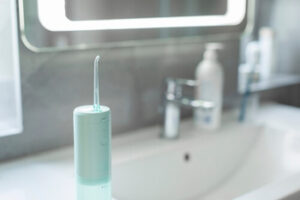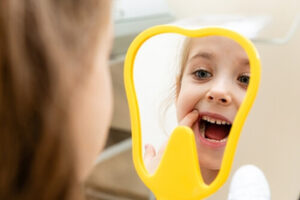When it comes to protecting your family’s smiles, especially your little ones, fluoride is a name you’ve probably heard more than once. But what does fluoride do exactly? And why do dental professionals consider it so essential for both children and adults?
In this comprehensive guide, we’ll uncover everything you need to know about fluoride, from how it works to prevent tooth decay to its role in kids’ dentistry and even the truth about potential risks from excess fluoride. Whether you’re a parent trying to safeguard your child’s oral health or simply curious about your own dental care, we’ve got you covered.
Let’s Start with the Basics: What Is Fluoride?
Fluoride is a naturally occurring mineral found in many foods, soil, rocks, and even oceans. You’ll also find it in our drinking water, toothpaste, and mouth rinses. But its claim to fame? It plays a crucial role in preventing tooth decay and maintaining strong tooth enamel.
Fluoride works by strengthening enamel, the outer layer of your teeth, making it more resistant to acid attacks caused by bacteria and sugars. This mineral also helps reverse early signs of tooth decay, which is why it’s become a staple in modern dental care.
Fluoride for Kids: What Makes It a Must-Have in Dental Care?

From strengthening developing teeth to reversing the early signs of decay, fluoride plays a quiet but powerful role in preventing tooth decay long before cavities have a chance to appear. Let’s examine why this naturally occurring mineral is considered essential for children’s oral health.
Fluoride Helps Build Strong Teeth from the Start
Children’s teeth are still developing, which makes them more vulnerable to acid attacks caused by bacteria and sugars in the mouth. These acids wear away tooth enamel, eventually leading to dental caries (cavities). Fluoride helps by being absorbed into the enamel, making it stronger and more resistant to breakdown.
This is particularly crucial during the early years, as both baby teeth and permanent teeth are forming. By incorporating fluoride toothpaste, fluoridated water, or professional fluoride treatments, your child’s enamel can handle daily wear and tear better.
Early Tooth Decay? Fluoride Can Reverse the Damage
If your child has ever had white spots on their teeth, it could be an early sign of tooth decay. The good news? Fluoride doesn’t just prevent damage; it can actually reverse these early signs by encouraging the remineralisation of enamel.
This is why fluoride is a key part of caries prevention in children. Used consistently, it helps stop decay before it progresses into something more serious, like cavities or infections that may require fillings or extractions.
Kids with Braces Need Fluoride Even More
Braces and other orthodontic devices can create tiny spaces that trap food and plaque, making it harder for kids to clean their teeth properly. This increases the risk of decay around the orthodontic brackets.
Fluoride offers an added layer of protection here. Whether it’s from fluoride mouth rinses at home or in-office fluoride treatments, this extra support can help protect those hard-to-reach areas and keep your child’s dental health in check throughout their orthodontic journey.
Fluoride Works Best as a Team Player
No single method of using fluoride is a silver bullet. The best protection comes from combining different sources, such as:
- Brushing teeth twice daily with fluoride toothpaste
- Drinking fluoridated tap water throughout the day
- Attending regular check-ups for professional fluoride treatment
- Using fluoride supplements or mouth rinses when advised by your dentist
Together, these methods create a multi-layered defence system for your child’s teeth, helping them stay cavity-free and confident in their smile.
Prevention Is Easier (and Cheaper) Than Treatment
One reason every major dental association champions fluoride is that it’s incredibly cost-effective. Preventing cavities through fluoride exposure saves families from expensive and sometimes invasive treatments later on.
A simple professional fluoride treatment at the dentist’s office or a switch to fluoridated toothpaste can mean fewer fillings, fewer dental visits, and a much more positive dental experience for your child.
The Different Forms of Fluoride in Your Child’s Dental Routine
Fluoride is one of the most powerful allies in your child’s fight against tooth decay, but did you know it comes in more than just toothpaste? From water-to-mouth rinses to professional applications at the dentist’s office, fluoride can enter your child’s oral routine in a variety of safe and effective ways.
Understanding where this natural mineral comes from and how it’s delivered can help you make the best decisions for your child’s dental health.
1. Fluoride Toothpaste: The Everyday Essential
Brushing teeth with fluoridated toothpaste is one of the most common and accessible ways to help kids build strong, cavity-resistant teeth.
- For children under 3, a tiny smear (about the size of a grain of rice) of low-fluoride toothpaste is recommended.
- For children aged 3 to 6, a pea-sized amount does the trick.
This small amount of fluoride is just enough to offer protection while keeping the risk of excess fluoride or swallowing too much to a minimum. Parents should supervise brushing and ensure children spit, not swallow, after brushing.
2. Fluoridated Tap Water: Easy, Safe and Effective

In Australia, community water fluoridation is widely practised to ensure the right fluoride concentration in the public water supply. According to the National Health and Medical Research Council, this method has significantly reduced dental caries in children across the country. And the best part? It’s a passive form of protection; all your child needs to do is drink tap water regularly.
Unlike many other treatments, fluoridated water provides small, consistent doses of fluoride throughout the day, supporting long-term oral health with minimal effort.
3. Fluoride Mouth Rinses: Extra Protection When Needed
Fluoride mouth rinses are often recommended for older children who may be more prone to cavities, especially those wearing orthodontic brackets or those with early signs of tooth decay.
These rinses contain a low concentration of fluoride and are available over the counter. However, they’re not typically recommended for children under 6 years old due to the risk of accidental swallowing and too much fluoride intake.
When used correctly, fluoride rinses offer added protection between brushing and dental visits, particularly in areas without fluoridated tap water.
4. Professional Fluoride Treatments at the Dentist’s Office
If your child is at high risk for dental caries, your dentist may recommend professional fluoride treatment during their regular check-up.
These treatments are fast, easy, and highly effective. They usually come in the form of:
- Fluoride varnish (painted onto the teeth)
- Fluoride gel or foam (applied in trays)
The fluoride concentration in these treatments is much higher than what’s found in toothpaste or mouth rinses, and a trained dental professional applies them. It’s a powerful way to strengthen teeth, reverse early tooth decay, and prevent cavities before they start.
5. Fluoride Supplements: When Water Isn’t Enough
In regions where fluoridated water isn’t available, your child’s dentist may recommend fluoride supplements, especially if your child is considered high-risk for cavities.
These come in tablets, drops, or lozenges and should only be used under the guidance of a dental professional or GP to avoid fluoride overexposure.
When used properly, fluoride supplements can fill the gap left by non-fluoridated drinking water and ensure your child still receives the benefits needed for caries prevention.
6. Naturally Present in Foods and Beverages
Fluoride is also naturally present in many foods, including tea, fish, eggs, and cooked spinach, though the levels are generally small. While dietary sources contribute to fluoride intake, they shouldn’t be relied on as the primary protection against cavities.
In fact, dietary supplements and fluoridated products remain more effective for preventing dental caries, particularly in growing children.
7. Combined Approach: The Best Defence Against Tooth Decay
Ultimately, the best way to support your child’s dental health is through a combination of:
- Brushing twice daily with fluoride toothpaste
- Drinking fluoridated tap water
- Visiting the dental office regularly for check-ups and fluoride treatments
- Using fluoride mouth rinses or supplements if advised
This layered approach offers comprehensive protection and ensures your child’s oral health stays on track from babyhood through their teenage years and beyond.
Fluoride vs Tooth Decay: Why This Mineral Matters
Fluoride’s main role is in preventing cavities, but it works in more than one way.
- Strengthening enamel: Fluoride helps repair weakened enamel by attracting minerals like calcium and phosphate.
- Inhibiting bacteria: It can reduce the ability of harmful bacteria in the mouth to produce acid.
- Reversing early damage: It can halt and even reverse the initial stages of decay before it becomes permanent damage.
The end result? Fewer cavities, less gum disease, and stronger, healthier smiles.
How Much Fluoride Is Too Much?
While fluoride is a champion in dental health, too much of it can pose health risks like anything else.
Dental Fluorosis: What You Need to Know
Dental fluorosis occurs when children ingest too much fluoride while their permanent teeth are still forming. It usually results in faint white spots on the teeth. While mostly cosmetic and not harmful, it’s a sign that fluoride intake needs adjusting.
Skeletal Fluorosis and High Doses
Rare but more serious is skeletal fluorosis, which results from high doses of fluoride over a long period. This condition affects bones and joints but is extremely unlikely with normal use of fluoride products or drinking fluoridated tap water.
Understanding Fluoride Exposure: Sources and Safe Levels
As we touched on earlier, fluoride comes from a variety of sources, and it’s important to keep these in balance to support healthy teeth without overexposure
Common Sources of Fluoride Exposure
- Tap water (if fluoridated)
- Fluoridated toothpaste
- Mouth rinses
- Dietary supplements
- Foods and drinks made with fluoridated water
Even breast milk contains a small amount of fluoride, though much lower than formula made with fluoridated water.
Managing Fluoride Intake in Children
If you’re unsure how much fluoride your child is getting, speak with your dental professional. They can evaluate total fluoride exposure and adjust accordingly, especially if your child uses multiple fluoride products or takes fluoride supplements.
How Dentists Help Monitor Fluoride Use
Your dental professional plays a key role in making sure your fluoride intake is just right.
At your child’s regular check-up, they’ll:
- Assess your child’s fluoride exposure
- Provide professional fluoride treatment if needed
- Recommend low-fluoride toothpaste if appropriate
- Guide you on the safe use of mouth rinses and dietary supplements
This tailored approach ensures your child receives all the benefits of fluoride without the risks of too much fluoride.
Adults Benefit Too: It’s Not Just for Kids
While fluoride is heavily emphasised in children’s dentistry, adults benefit just as much, especially if they’re at risk of decay or gum disease.
Adults with conditions like dry mouth, gum recession, or who wear orthodontic brackets, crowns, or bridges can all benefit from fluoride treatments to keep decay at bay.
Debunking the Myths Around Fluoride
Despite decades of medical research, fluoride is still misunderstood by some.
“Fluoride Is Dangerous!”
In the right amounts, fluoride is not only safe but highly effective. Numerous global health authorities, including the Australian Dental Association, National Toxicology Program, and Medical Research Council, support the use of fluoride for public health.
“We Don’t Need Fluoride If We Brush Our Teeth”

“Natural Is Better: Remove Fluoride!”
While some advocate for ways to remove fluoride from water, it’s essential to understand that fluoride is a natural mineral. What’s added to drinking water is usually sodium fluoride, the same compound found in nature, just controlled for safety and consistency.
FAQs About Fluoride and Dental Health
- Is fluoride safe for babies and toddlers?
Yes, in the right amounts. Use a smear of low fluoride toothpaste for babies and toddlers, and supervise brushing to avoid swallowing.
- Can I get enough fluoride from my diet?
Not typically. While many foods contain trace amounts, they aren’t enough to offer the protective benefits of fluoridated water or toothpaste.
- Should I be worried about fluoride in tap water?
Not at all. Drinking fluoridated tap water is both safe and recommended by leading health organisations worldwide.
- What if I live in an area without water fluoridation?
Your dentist may recommend fluoride supplements or professional fluoride treatments to make up for the difference.
- Can too much fluoride harm my child?
It can, which is why it’s important to follow your dentist’s advice and supervise fluoride use, especially in younger children.
Final Thoughts: So, What Does Fluoride Do?
In a nutshell, fluoride is one of the most powerful tools we have for preventing dental caries, strengthening tooth enamel, and protecting smiles from early tooth decay through adulthood.
Whether it’s through fluoridated tap water, fluoride toothpaste, or in-office fluoride treatments, this naturally present mineral is a safe, effective, and affordable way to boost your family’s oral health.
For parents, embracing fluoride as part of your child’s dental care routine is one of the best choices you can make for their future smile. And if you ever have concerns or questions about fluoride intake, contact Dental 266 at 02 9051 0600, they’re there to help guide you every step of the way.
References
- Australian Dental Association. (n.d.). Home. https://ada.org.au/
- Cleveland Clinic. (n.d.). Fluorosis. https://my.clevelandclinic.org/health/diseases/23227-fluorosis
- Cherney, K. (2023). Fluoride treatment: Benefits, side effects, recommendations. Healthline. https://www.healthline.com/health/dental-and-oral-health/fluoride-treatment
- Mayo Clinic Staff. (2023). Cavities/tooth decay. Mayo Clinic. https://www.mayoclinic.org/diseases-conditions/cavities/symptoms-causes/syc-20352892
- Colgate. (n.d.). Oral bacteria: What lives in your mouth? https://www.colgate.com/en-us/oral-health/mouth-and-teeth-anatomy/oral-bacteria-what-lives-in-your-mouth#






